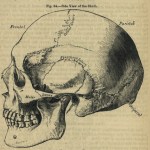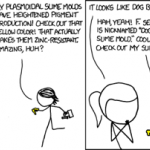biology
When I was a kid, beavers were kind of exotic animals that lived in distant parts, like bears or wolverines. Over the past decade or two though, they've multiplied here in Nacka municipality, much as the wild boar population has exploded in this part of Sweden. Still, the beavers haven't really reached my part of Nacka -- until now.
Today I found their tell-tale felled trees on the edge of the fen next to the Ãstervik commuter train station, a few minutes by bike from my home. This means that soon we'll see them in Lake Lundsjön / Dammsjön where we swim every summer! (It used to be two…
I'd like to thank Buckeye Surgeon for reminding me of something I had seen and wanted to blog about but totally forgot about. Maybe it was so forgettable that I should just skip it, but as a surgeon I actually don't think so. Basically, it's a story of a surgeon making a fool of himself. I know, I know, that's such an impossibility that it's well nigh inconceivable, but it actually did happen. Perhaps what brought my attention to this sordid tale is that there is a connection to the University of Michigan, where I went to both undergraduate and medical school.
The surgeon in question is Dr.…
Anatomical engraving from Henry Gray's Anatomy, 1858.
A month or so ago, Abrams books reached out to mention that they were releasing a new title, Human Anatomy: A Visual History from the Renaissance to the Digital Age. I said, "don't I already have this book?" It turns out I did - I had the previous, hardback edition which I picked up for $25 or so on Amazon (a deal, I thought at the time). So I knew this book should really be subtitled "vintage eye candy from Vesalius to Schmiedel," because it's a bundle of rich images from anatomical atlases, interspersed with just enough curation to give…
"Reasoning was not designed to pursue the truth. Reasoning was designed by evolution to help us win arguments."
- Jonathan Haidt, "The New Science of Morality",
invoking the work of H. Mercier and D. Sperber.
(the whole talk is really interesting).
Oh, to be eight years old again, and oh-so-eager to suspend all disbelief. . . this video had me laughing in pure delight:
The baby T-Rex, which you can obviously tell is an actor (see the legs?) is touring Australian schools to promote the show "Walking with Dinosaurs." Don't get me wrong - the show looks as charming as a James Gurney musical - but I really love the expressions on the childrens' faces as they're alternately surprised, scared, and thrilled. I think I just saw four or five future paleontologists spring into being. . .
Via, like, everybody. It's dinoviral.
Haute Macabre found artist Celina Saubidet on etsy, where she sells silver-plated bronze "osseous jewelry" from her shop Joyeria Osea. I think this skeletal hand is pretty over the top, but hey - sometimes you need a little drama. Check out her fingerbone rings for a more subtle anatomical statement.
Adam Winnik sent me this animation inspired by Carl Sagan's famous "pale blue dot" monologue. It's true to the serious implications of Sagan's words, yet wry and lighthearted (mostly). A lovely example of remix culture revitalizing a classic of biology.
Adam gives some background:
I've been enrolled in illustration at Sheridan College for the the last 4 years and this is my final thesis project. I have always thought of Carl Sagan's writings as "scientific poetry" since they lack the cold touch that science is often cursed for having. I think Sagan's words resonate more than ever, and will…
While we're on the bioanimation topic, I recently heard from Jess at Nervous System, who sent me links to some animations of their new jewelry line, hyphae, "growing" in virtual space. Check it out:
Hyphae - growth of the Vessel Pendant from Nervous System on Vimeo.
They explain,
Hyphae is a collection of 3D printed artifacts constructed of rhizome-like networks. Inspired by the vein structures that carry fluids through organisms from the leaves of plants to our own circulatory systems, we created a simulation which uses physical growth principles to build sculptural, organic structures.…
Remember when I said more bio grad students should play with coding and modeling? Here's an example of what I mean. Laurence Frabotta directed me to this animation by phylogeneticist/bioinformatics programmer Liam Revell, an assistant professor at U Mass Boston, who used the statistical package 'R' to write a short code generating all possible bifurcating and multifurcating phylogenetic trees for a set of taxa. Apparently there are 2,752 for seven taxa (I have to take his word for it, my basic math skills have long since escaped me) and this animation runs through all of them. It's not…
Wow - my post about unhappy bio grad students is getting massive traffic. (Hi SlashDotters and StumbleUpon-ers!) Mike the Mad Biologist, my original inspiration, has responded here and here to all the buzz.
I pretty much said everything I wanted to say in the original post, and I don't pretend to have an explanation or cure for this problem. But I see that there's been some snarkiness on the intertubez (shocking!!!) while I was away watching the developments in the Myriad appeal. So I want to clarify two points.
First, let me emphasize that I'm not saying graduate students in other fields don…
The oral arguments in Monday's Myriad appeal are online here. (Scroll down and look for Association for Molecular [Pathology] v. PTO).
Tomorrow morning, a three-judge panel of the Court of Appeals for the Federal Circuit will hear arguments in the appeal of Association for Molecular Pathology v. U.S. Patent and Trademark Office - better known as the Myriad gene patent case.* It has the patent and genetic blogospheres in a bit of a tizzy, and the mainstream media is picking up on it too. See, for example, this Atlantic article by Andrew Cohen, this Nature.com editorial by my friend Shobita Parthasarathy, and even a "Spectator's Guide to the Myriad Oral Argument" by Genomics Law Report -- which has a dedicated icon and…
The myriad miseries of graduate school are reserved to no one discipline, but there may be something to the contention that biology graduate programs are particularly bad. Here's what Mike the Mad Biologist says, in response to Science Professor, and I think he's quite right:
The basic problem stems (so to speak) from too many biology Ph.D.s and not enough funding, leading to an immensely cutthroat environment--and one that is psychologically damaging to boot. . . .So why does this dysfunctional cultural paradigm exist? I think it has to do with two things: specialization and Ph.D. training…
Here's Alexis Madrigal on why the slow loris' newfound YouTube fame could be the worst possible thing for the little primates:
Talk about a buzzkill: watching a video of a cute animal on the Internet may -- in some small way -- lead to it being ripped from its mother, abused, and sold on the global market.
I know, I know: most of us can coo over small furry critters with extreme neoteny, while refraining from buying them on the black market. And it's not YouTube's fault that the loris is adorable. It's just truly sad that popularizing an endangered animal most people don't even realize exists…
Yesterday, I learned of how animal rights terrorists are targeting college students as the "soft underbelly of the vivisection movement." As an example of their new strategy, these thugs gloated over the "recantation" by a Florida Atlantic University student named Alena Rodriguez, who, because of her e-mail to a Negotiation Is Over editor named Ghazal Tajalli rejecting her request to become involved in an animal rights event, was targeted for a campaign of intimidation, smears, and harassment. As a result, Rodriguez was sufficiently terrified that she basically gave the thugs what they wanted…
I've made no secret of my disdain for self-proclaimed "animal rights" activists, the ones who are more than willing to terrorize scientists doing research to understand disease better and thereby develop better treatments and even cures. None of this means that I am some sort of "animal abuser" (to steal the animal rights jargon) or that I'm cruel and advocate "torturing" animals. There is a difference between animal rights and animal welfare; animal rights activists in essence equate a mouse with a rat with a dog with a pig with a human being. In any case, I've reported how animal rights…
The vermin only teaze and pinch
Their foes superior by an inch.
So, naturalists observe, a flea
Has smaller fleas that on him prey;
And these have smaller still to bite 'em,
And so proceed ad infinitum.
Jonathan Swift, "On Poetry: A Rhapsody"
There's so much to love about this story from Nature News. While surveying genetic snippets from a hypersaline lake in Antarctica, an Australian research team found a virus that preys on other viruses. And they sorted out the ecology of the lake well enough to figure out that the virus infected by the virus-infecting virus is a major predator on the…
Grant time again! Since today--yes, today!--is the deadline for a rather big grant I'm writing (not quite R01 level, but a respectable three year project if I can get it), I was up until the wee hours of the morning trying to put this sucker to bed. Being the ever-benevolent blogger, though, far be it from me to deny you some Insolence. It's just recycled Insolence. Of course, given that this is nearly four years old, if you've been reading less than four years, it's new to you! I'll be back tomorrow; that is, assuming I've recovered. As I look at this post, it occurs to me that I haven't…
This is the biologist googly-eyed dazzled-with-biological-complexity effect that my friends and I used to describe as "because little fishes have eyes!" Be warned: once infected with the appreciation for biological beauty, there is no cure. :)
This is why I love xkcd. How is it possible I still run into people all the time who don't read it???
A really interesting post from Deborah Blum on the "radium girls" who painted wristwatches in the 1920s - to fatal effect:
At the factory, the dial painters were taught to shape their brushes to a fine point with their lips, producing the sharp tip needed to paint the tiny numbers and lines of watch dials, the lacy designs of fashionable clocks. Each worker was expected to paint 250 dials a day, five and a half days a week. They earned about $20 a week for that work, at a rate of one and a half cents per completed dial.
The painters were teen-aged girls and young women who became friendly…


